Polyphenol-Hydroxylating Tyrosinase Activity under Acidic pH Enables Efficient Synthesis of Plant Catechols and Gallols
Abstract
:1. Introduction
2. Materials and Methods
2.1. Materials
2.2. Measurement of Flavonoid pH Stability
2.3. Tyrosinase Activity Assay
2.4. Kaempferol Conversion Using BmTy at Various pHs
2.5. MS Identification of Various Ortho-Hydroxylated Products
2.6. Biosynthesis of Quercetin and Myricetin Using BmTy
2.7. HPLC Analysis
2.8. Preliminary Enzyme Deactivation Tests with the Incubation of Flavonols
2.9. BmTy Inhibition Kinetics of Quercetin
3. Results
3.1. Measurement of pH Stability of Quercetin and Myricetin
3.2. Screening Bacterial Tyrosinases for Polyphenol Conversion under Acidic Condition
3.3. Effect of pH on the Kaempferol Conversion by BmTy
3.4. MS Identification of Tyrosinase Products
3.5. Production of Quercetin and Myricetin from Kaempferol Using BmTy
3.6. Inhibitory Action of Quercetin in Monophenolase Activity of BmTy
4. Discussion
5. Conclusions
Supplementary Materials
Author Contributions
Funding
Conflicts of Interest
Abbreviations
| MRI | magnetic resonance imaging |
| CYP | cytochrome P450 |
| NAD(P) | nicotinamide adenine dinucleotide (phosphate) |
| MS | mass spectrometry |
| HPLC | high performance liquid chromatography |
| Ni-NTA | nickel-nitrilotriacetic acid |
| UV/Vis | ultraviolet/visible light |
| GC | gas chromatography |
| ESI | electrospray ionization |
| EI | electron ionization |
| EA | ethyl acetate |
| KAE | kaempferol |
| QUE | quercetin |
| MYR | myricetin |
| CAT | catechol |
| QUI | o-quinone |
| L-DOPA | L-3,4-dihydroxyphenylalanine |
| LAA | L-ascorbic acid |
| PVP | poly(vinyl pyrrolidone) |
| BSTFA | N,O-Bis(trimethylsilyl)trifluoroacetamide |
| TMS | trimethylsilyl |
| TON | turnover number |
References
- McLarin, M.-A.; Leung, I.K.H. Substrate specificity of polyphenol oxidase. Crit. Rev. Biochem. Mol. Biol. 2020, 55, 274–308. [Google Scholar] [CrossRef]
- Solomon, E.I.; Sundaram, U.M.; Machonkin, T.E. Multicopper Oxidases and Oxygenases. Chem. Rev. 1996, 96, 2563–2606. [Google Scholar] [CrossRef] [PubMed]
- Muñoz-Muñoz, J.L.; Berna, J.; García-Molina, M.d.M.; Garcia-Molina, F.; Garcia-Ruiz, P.A.; Varon, R.; Rodriguez-Lopez, J.N.; Garcia-Canovas, F. Hydroxylation of p-substituted phenols by tyrosinase: Further insight into the mechanism of tyrosinase activity. Biochem. Biophys. Res. Commun. 2012, 424, 228–233. [Google Scholar] [CrossRef] [PubMed]
- Lee, S.-H.; Baek, K.; Lee, J.-E.; Kim, B.-G. Using tyrosinase as a monophenol monooxygenase: A combined strategy for effective inhibition of melanin formation. Biotechnol. Bioeng. 2016, 113, 735–743. [Google Scholar] [CrossRef]
- Lee, N.; Lee, S.-H.; Baek, K.; Kim, B.-G. Heterologous expression of tyrosinase (MelC2) from Streptomyces avermitilis MA4680 in E. coli and its application for ortho-hydroxylation of resveratrol to produce piceatannol. Appl. Microbiol. Biotechnol. 2015, 99, 7915–7924. [Google Scholar] [CrossRef] [PubMed]
- Min, K.; Park, G.W.; Yoo, Y.J.; Lee, J.-S. A perspective on the biotechnological applications of the versatile tyrosinase. Bioresour. Technol. 2019, 289, 121730. [Google Scholar] [CrossRef]
- Ju, K.-Y.; Lee, J.W.; Im, G.H.; Lee, S.; Pyo, J.; Park, S.B.; Lee, J.H.; Lee, J.-K. Bio-Inspired, Melanin-Like Nanoparticles as a Highly Efficient Contrast Agent for T1-Weighted Magnetic Resonance Imaging. Biomacromolecules 2013, 14, 3491–3497. [Google Scholar] [CrossRef]
- Wang, W.; Jing, T.; Xia, X.; Tang, L.; Huang, Z.; Liu, F.; Wang, Z.; Ran, H.; Li, M.; Xia, J. Melanin-loaded biocompatible photosensitive nanoparticles for controlled drug release in combined photothermal-chemotherapy guided by photoacoustic/ultrasound dual-modality imaging. Biomater. Sci. 2019, 7, 4060–4074. [Google Scholar] [CrossRef]
- Ju, K.-Y.; Kang, J.; Pyo, J.; Lim, J.; Chang, J.H.; Lee, J.-K. pH-Induced aggregated melanin nanoparticles for photoacoustic signal amplification. Nanoscale 2016, 8, 14448–14456. [Google Scholar] [CrossRef] [Green Version]
- Kohri, M.; Nannichi, Y.; Taniguchi, T.; Kishikawa, K. Biomimetic non-iridescent structural color materials from polydopamine black particles that mimic melanin granules. J. Mater. Chem. C 2015, 3, 720–724. [Google Scholar] [CrossRef]
- Barbehenn, R.V.; Constabel, C.P. Tannins in plant–herbivore interactions. Phytochemistry 2011, 72, 1551–1565. [Google Scholar] [CrossRef]
- Mandal, S.M.; Chakraborty, D.; Dey, S. Phenolic acids act as signaling molecules in plant-microbe symbioses. Plant Signal. Behav. 2010, 5, 359–368. [Google Scholar] [CrossRef] [Green Version]
- Harborne, J.B. The Flavonoids: Advances in Research Since 1980; Springer: New York, NY, USA, 2013. [Google Scholar]
- Daino, G.L.; Frau, A.; Sanna, C.; Rigano, D.; Distinto, S.; Madau, V.; Esposito, F.; Fanunza, E.; Bianco, G.; Taglialatela-Scafati, O.; et al. Identification of Myricetin as an Ebola Virus VP35–Double-Stranded RNA Interaction Inhibitor through a Novel Fluorescence-Based Assay. Biochemistry 2018, 57, 6367–6378. [Google Scholar] [CrossRef] [PubMed] [Green Version]
- Bimakr, M.; Rahman, R.A.; Taip, F.S.; Ganjloo, A.; Salleh, L.M.; Selamat, J.; Hamid, A.; Zaidul, I.S.M. Comparison of different extraction methods for the extraction of major bioactive flavonoid compounds from spearmint (Mentha spicata L.) leaves. Food Bioprod. Process. 2011, 89, 67–72. [Google Scholar] [CrossRef]
- Azmir, J.; Zaidul, I.S.M.; Rahman, M.M.; Sharif, K.M.; Mohamed, A.; Sahena, F.; Jahurul, M.H.A.; Ghafoor, K.; Norulaini, N.A.N.; Omar, A.K.M. Techniques for extraction of bioactive compounds from plant materials: A review. J. Food Eng. 2013, 117, 426–436. [Google Scholar] [CrossRef]
- Chaves, J.O.; de Souza, M.C.; Da Silva, L.C.; Lachos-Perez, D.; Torres-Mayanga, P.C.; Machado, A.; Forster-Carneiro, T.; Vázquez-Espinosa, M.; González-De-Peredo, A.V.; Barbero, G.F.; et al. Extraction of Flavonoids From Natural Sources Using Modern Techniques. Front. Chem. 2020, 8, 507887. [Google Scholar] [CrossRef]
- Azwanida, N.N. A Review on the Extraction Methods Use in Medicinal Plants, Principle, Strength and Limitation. Med. Aromat. Plants 2015, 4, 1–6. [Google Scholar] [CrossRef]
- Wang, L.; Weller, C.L. Recent advances in extraction of nutraceuticals from plants. Trends Food Sci. Technol. 2006, 17, 300–312. [Google Scholar] [CrossRef]
- Pandey, R.P.; Parajuli, P.; Koffas, M.A.; Sohng, J.K. Microbial production of natural and non-natural flavonoids: Pathway engineering, directed evolution and systems/synthetic biology. Biotechnol. Adv. 2016, 34, 634–662. [Google Scholar] [CrossRef] [Green Version]
- Du, Y.; Yang, B.; Yi, Z.; Hu, L.; Li, M. Engineering Saccharomyces cerevisiae Coculture Platform for the Production of Flavonoids. J. Agric. Food Chem. 2020, 68, 2146–2154. [Google Scholar] [CrossRef] [PubMed]
- Marín, L.; Gutiérrez-Del-Río, I.; Entrialgo-Cadierno, R.; Villar, C.J.; Lombó, F. De novo biosynthesis of myricetin, kaempferol and quercetin in Streptomyces albus and Streptomyces coelicolor. PLoS ONE 2018, 13, e0207278. [Google Scholar] [CrossRef] [PubMed] [Green Version]
- Jones, J.A.; Vernacchio, V.R.; Sinkoe, A.L.; Collins, S.M.; Ibrahim, M.H.A.; Lachance, D.M.; Hahn, J.; Koffas, M.A.G. Experimental and computational optimization of an Escherichia coli co-culture for the efficient production of flavonoids. Metab. Eng. 2016, 35, 55–63. [Google Scholar] [CrossRef]
- Deze Kong, S.L.; Smolke, C.D. Discovery of a previously unknown biosynthetic capacity of naringenin chalcone synthase by heterologous expression of a tomato gene cluster in yeast. Sci. Adv. 2020, 6, eabd1143. [Google Scholar] [CrossRef]
- Ayabe, S.-I.; Akashi, T. Cytochrome P450s in flavonoid metabolism. Phytochem. Rev. 2006, 5, 271–282. [Google Scholar] [CrossRef]
- Lee, P.-G.; Lee, S.-H.; Kim, J.; Kim, E.-J.; Choi, K.-Y.; Kim, B.-G. Polymeric solvent engineering for gram/liter scale production of a water-insoluble isoflavone derivative, (S)-equol. Appl. Microbiol. Biotechnol. 2018, 102, 6915–6921. [Google Scholar] [CrossRef] [PubMed]
- Lee, P.-G.; Lee, S.-H.; Hong, E.Y.; Lutz, S.; Kim, B.-G. Circular permutation of a bacterial tyrosinase enables efficient polyphenol-specific oxidation and quantitative preparation of orobol. Biotechnol. Bioeng. 2019, 116, 19–27. [Google Scholar] [CrossRef] [Green Version]
- Shuster, V.; Fishman, A. Isolation, Cloning and Characterization of a Tyrosinase with Improved Activity in Organic Solvents from Bacillus megaterium. J. Mol. Microbiol. Biotechnol. 2009, 17, 188–200. [Google Scholar] [CrossRef] [PubMed]
- Moon, Y.J.; Wang, L.; DiCenzo, R.; Morris, M.E. Quercetin pharmacokinetics in humans. Biopharm. Drug Dispos. 2008, 29, 205–217. [Google Scholar] [CrossRef] [PubMed]
- Wang, W.; Sun, C.; Mao, L.; Ma, P.; Liu, F.; Yang, J.; Gao, Y. The biological activities, chemical stability, metabolism and delivery systems of quercetin: A review. Trends Food Sci. Technol. 2016, 56, 21–38. [Google Scholar] [CrossRef]
- Xiang, D.; Wang, C.G.; Wang, W.-Q.; Shi, C.-Y.; Xiong, W.; Wang, M.-D.; Fang, J.-G. Gastrointestinal stability of dihydromyricetin, myricetin, and myricitrin: An in vitro investigation. Int. J. Food Sci. Nutr. 2017, 68, 704–711. [Google Scholar] [CrossRef] [PubMed]
- Yao, Y.; Lin, G.; Xie, Y.; Ma, P.; Li, G.; Meng, Q.; Wu, T. Preformulation studies of myricetin: A natural antioxidant flavonoid. Die Pharmazie Int. J. Pharm. Sci. 2014, 69, 19–26. [Google Scholar]
- Franklin, S.J.; Myrdal, P.B. Solid-State and Solution Characterization of Myricetin. AAPS PharmSciTech 2015, 16, 1400–1408. [Google Scholar] [CrossRef] [PubMed] [Green Version]
- Jang, J.-H.; Park, Y.-D.; Ahn, H.-K.; Kim, S.-J.; Lee, J.-Y.; Kim, E.-C.; Chang, Y.-S.; Song, Y.-J.; Kwon, H.-J. Analysis of Green Tea Compounds and Their Stability in Dentifrices of Different pH Levels. Chem. Pharm. Bull. 2014, 62, 328–335. [Google Scholar] [CrossRef] [Green Version]
- Schüsler-Van Hees, M.T.I.W.; Beijersbergen Van Henegouwen, G.M.J.; Stoutenberg, P. Autoxidation of catechol(amine)s. Pharmaceutisch Weekblad 1985, 7, 245–251. [Google Scholar] [CrossRef] [PubMed]
- Gao, R.; Yuan, Z.; Zhao, Z.; Gao, X. Mechanism of pyrogallol autoxidation and determination of superoxide dismutase enzyme activity. Bioelectrochem. Bioenerg. 1998, 45, 41–45. [Google Scholar] [CrossRef]
- Lee, N.; Kim, E.J.; Kim, B.-G. Regioselective Hydroxylation of trans-Resveratrol via Inhibition of Tyrosinase from Streptomyces avermitilis MA4680. ACS Chem. Biol. 2012, 7, 1687–1692. [Google Scholar] [CrossRef]
- Kim, S.-H.; Lee, S.-H.; Lee, J.-E.; Park, S.J.; Kim, K.; Kim, I.S.; Lee, Y.-S.; Hwang, N.S.; Kim, B.-G. Tissue adhesive, rapid forming, and sprayable ECM hydrogel via recombinant tyrosinase crosslinking. Biomaterials 2018, 178, 401–412. [Google Scholar] [CrossRef]
- Seo, J.-H.; Park, J.; Kim, E.-M.; Kim, J.; Joo, K.; Lee, J.; Kim, B.-G. Subgrouping Automata: Automatic sequence subgrouping using phylogenetic tree-based optimum subgrouping algorithm. Comput. Biol. Chem. 2014, 48, 64–70. [Google Scholar] [CrossRef]
- Son, H.F.; Lee, S.-H.; Lee, S.H.; Kim, H.; Hong, H.; Lee, U.-J.; Lee, P.-G.; Kim, B.-G.; Kim, K.-J. Structural Basis for Highly Efficient Production of Catechol Derivatives at Acidic pH by Tyrosinase from Burkholderia thailandensis. ACS Catal. 2018, 8, 10375–10382. [Google Scholar] [CrossRef]
- Chiang, C.-M.; Wang, D.-S.; Chang, T.-S. Improving Free Radical Scavenging Activity of Soy Isoflavone Glycosides Daidzin and Genistin by 3′-Hydroxylation Using Recombinant Escherichia coli. Molecules 2016, 21, 1723. [Google Scholar] [CrossRef] [Green Version]
- Li, Y.; Zafar, A.; Kilmartin, P.A.; Reynisson, J.; Leung, I.K.H. Development and Application of an NMR-Based Assay for Polyphenol Oxidases. ChemistrySelect 2017, 2, 10435–10441. [Google Scholar] [CrossRef]
- Kim, D.; Park, J.; Kim, J.; Han, C.; Yoon, J.; Kim, N.; Seo, J.; Lee, C. Flavonoids as Mushroom Tyrosinase Inhibitors: A Fluorescence Quenching Study. J. Agric. Food Chem. 2006, 54, 935–941. [Google Scholar] [CrossRef] [PubMed]
- Kubo, I.; Kinst-Hori, I.; Chaudhuri, S.K.; Kubo, Y.; Sánchez, Y.; Ogura, T. Flavonols from Heterotheca inuloides : Tyrosinase Inhibitory Activity and Structural Criteria. Bioorg. Med. Chem. 2000, 8, 1749–1755. [Google Scholar] [CrossRef]
- Kubo, I.; Kinst-Hori, I. Flavonols from Saffron Flower: Tyrosinase Inhibitory Activity and Inhibition Mechanism. J. Agric. Food Chem. 1999, 47, 4121–4125. [Google Scholar] [CrossRef]
- Fan, M.; Zhang, G.; Hu, X.; Xu, X.; Gong, D. Quercetin as a tyrosinase inhibitor: Inhibitory activity, conformational change and mechanism. Food Res. Int. 2017, 100, 226–233. [Google Scholar] [CrossRef] [PubMed]
- Garcia-Jimenez, A.; Teruel-Puche, J.A.; Garcia-Ruiz, P.A.; Saura-Sanmartin, A.; Berna, J.; Rodríguez-López, J.N.; Garcia-Canovas, F. Action of tyrosinase on caffeic acid and its n-nonyl ester. Catalysis and suicide inactivation. Int. J. Biol. Macromol. 2018, 107, 2650–2659. [Google Scholar] [CrossRef]
- Land, E.J.; Ramsden, C.A.; Riley, P.A. The mechanism of suicide-inactivation of tyrosinase: A substrate structure investigation. Tohoku J. Exp. Med. 2007, 212, 341–348. [Google Scholar] [CrossRef] [Green Version]
- Munoz-Munoz, J.L.; Berná, J.; Garcia-Molina, F.; García-Ruiz, P.A.; Tudela, J.; Rodriguez-Lopez, J.N.; García-Cánovas, F. Unravelling the suicide inactivation of tyrosinase: A discrimination between mechanisms. J. Mol. Catal. B Enzym. 2012, 75, 11–19. [Google Scholar] [CrossRef]
- Kim, S.-H.; An, Y.-H.; Kim, H.D.; Kim, K.; Lee, S.-H.; Yim, H.-G.; Kim, B.-G.; Hwang, N.S. Enzyme-mediated tissue adhesive hydrogels for meniscus repair. Int. J. Biol. Macromol. 2018, 110, 479–487. [Google Scholar] [CrossRef]
- Chávez-Béjar, M.I.; Balderas-Hernandez, V.E.; Gutiérrez-Alejandre, A.; Martínez, A.; Bolivar, F.; Gosset, G. Metabolic engineering of Escherichia coli to optimize melanin synthesis from glucose. Microb. Cell Factories 2013, 12, 108. [Google Scholar] [CrossRef] [Green Version]
- Wada, S.; Ichikawa, H.; Tastsumi, K. Removal of phenols and aromatic amines from wastewater by a combination treatment with tyrosinase and a coagulant. Biotechnol. Bioeng. 1995, 45, 304–309. [Google Scholar] [CrossRef]
- Kampatsikas, I.; Bijelic, A.; Pretzler, M.; Rompel, A. Three recombinantly expressed apple tyrosinases suggest the amino acids responsible for mono- versus diphenolase activity in plant polyphenol oxidases. Sci. Rep. 2017, 7, 8860. [Google Scholar] [CrossRef] [PubMed] [Green Version]
- Goldfeder, M.; Kanteev, M.; Adir, N.; Fishman, A. Influencing the monophenolase/diphenolase activity ratio in tyrosinase. Biochim. Biophys. Acta (BBA) Proteins Proteom. 2013, 1834, 629–633. [Google Scholar] [CrossRef] [PubMed]
- Do, H.; Kang, E.; Yang, B.; Cha, H.J.; Choi, Y.S. A tyrosinase, mTyr-CNK, that is functionally available as a monophenol monooxygenase. Sci. Rep. 2017, 7, 17267. [Google Scholar] [CrossRef] [PubMed] [Green Version]
- Hernandez-Romero, D.; Sanchez-Amat, A.; Solano, F. A tyrosinase with an abnormally high tyrosine hydroxylase/dopa oxidase ratio. FEBS J. 2006, 273, 257–270. [Google Scholar] [CrossRef]
- Solem, E.; Tuczek, F.; Decker, H. Tyrosinase versus Catechol Oxidase: One Asparagine Makes the Difference. Angew. Chem. Int. Ed. Engl. 2016, 55, 2884–2888. [Google Scholar] [CrossRef]

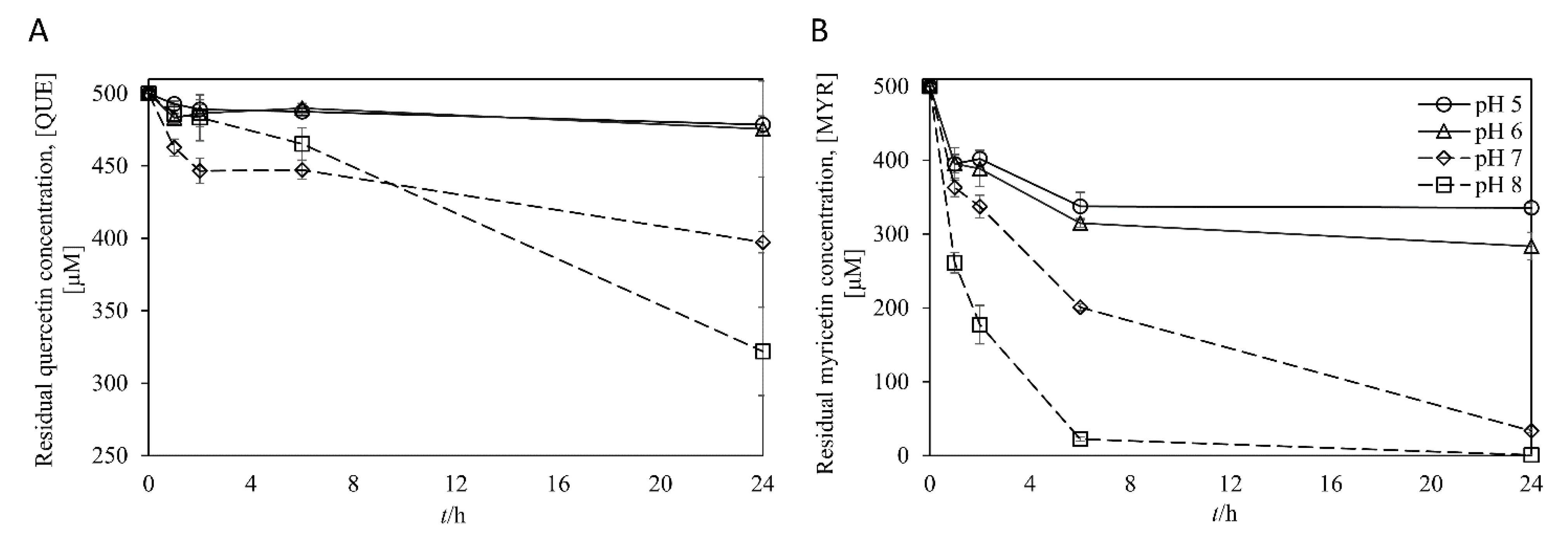
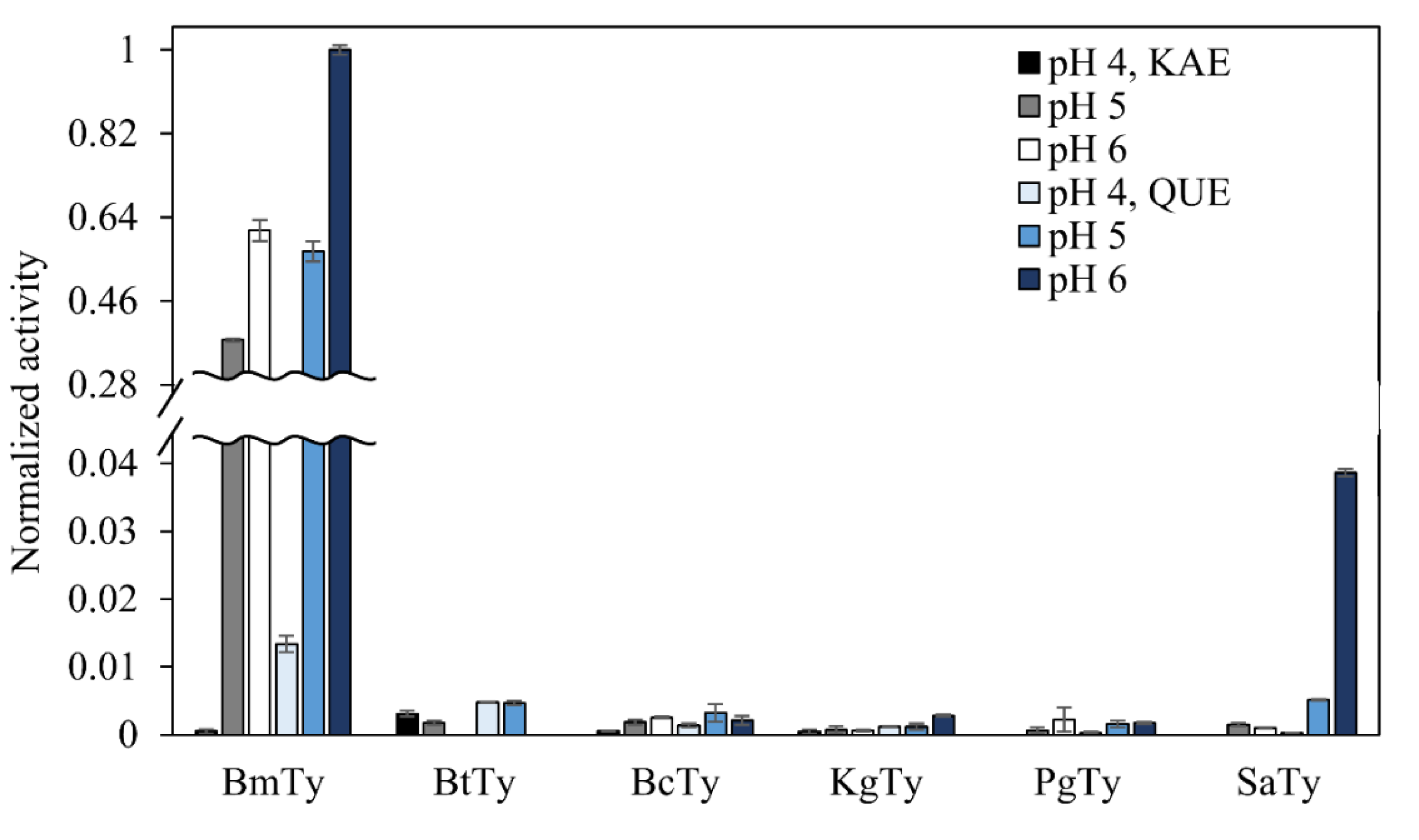
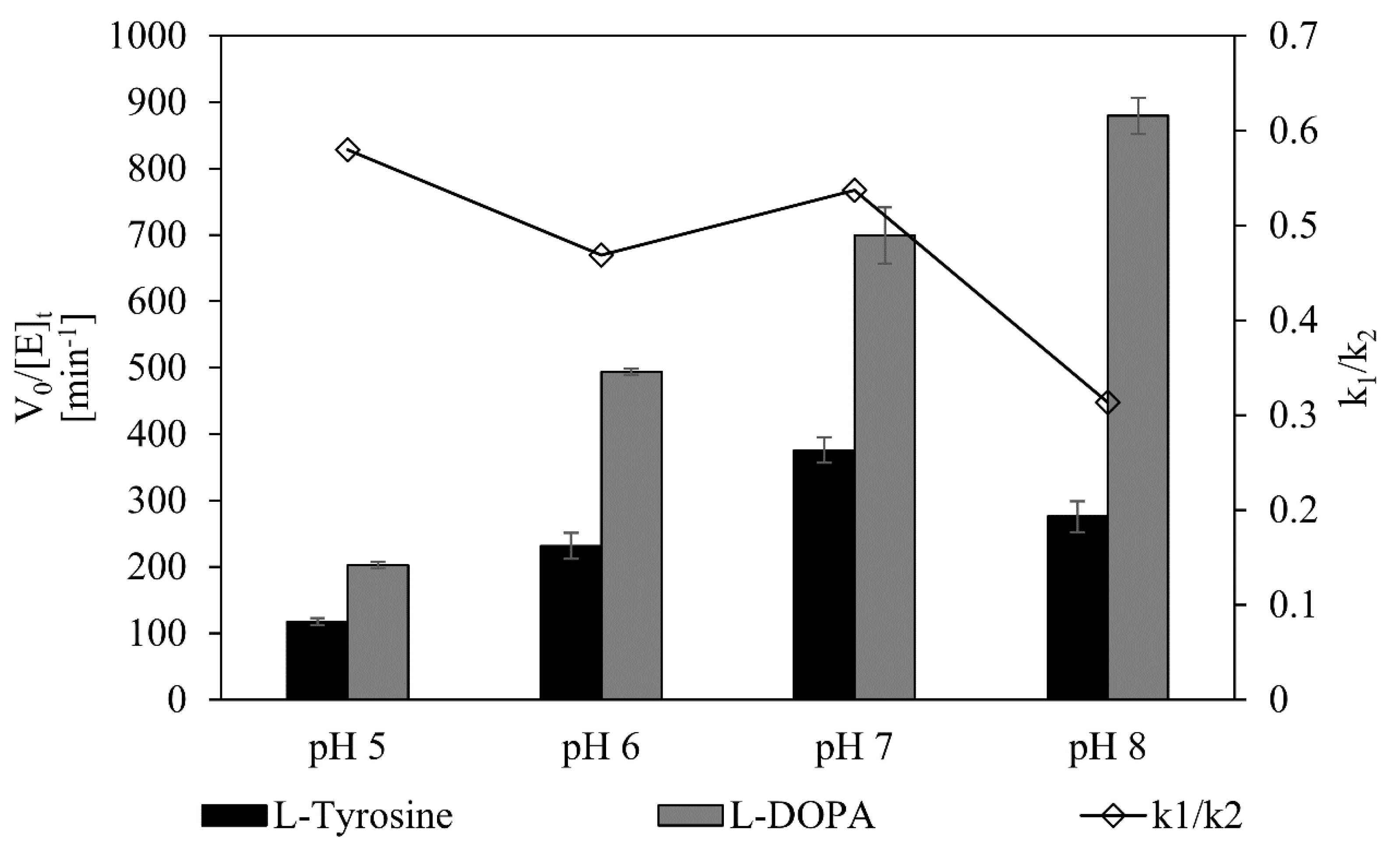

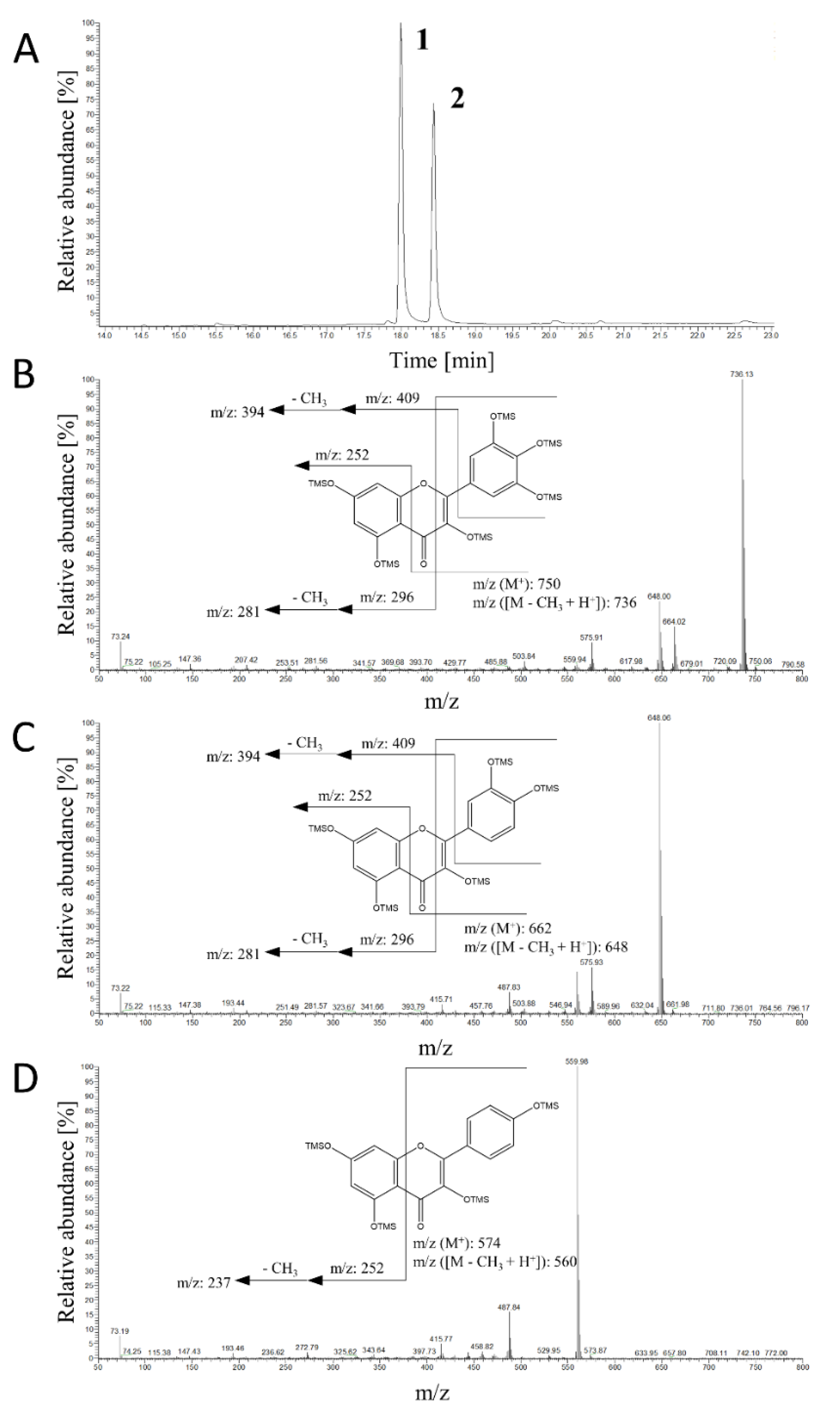
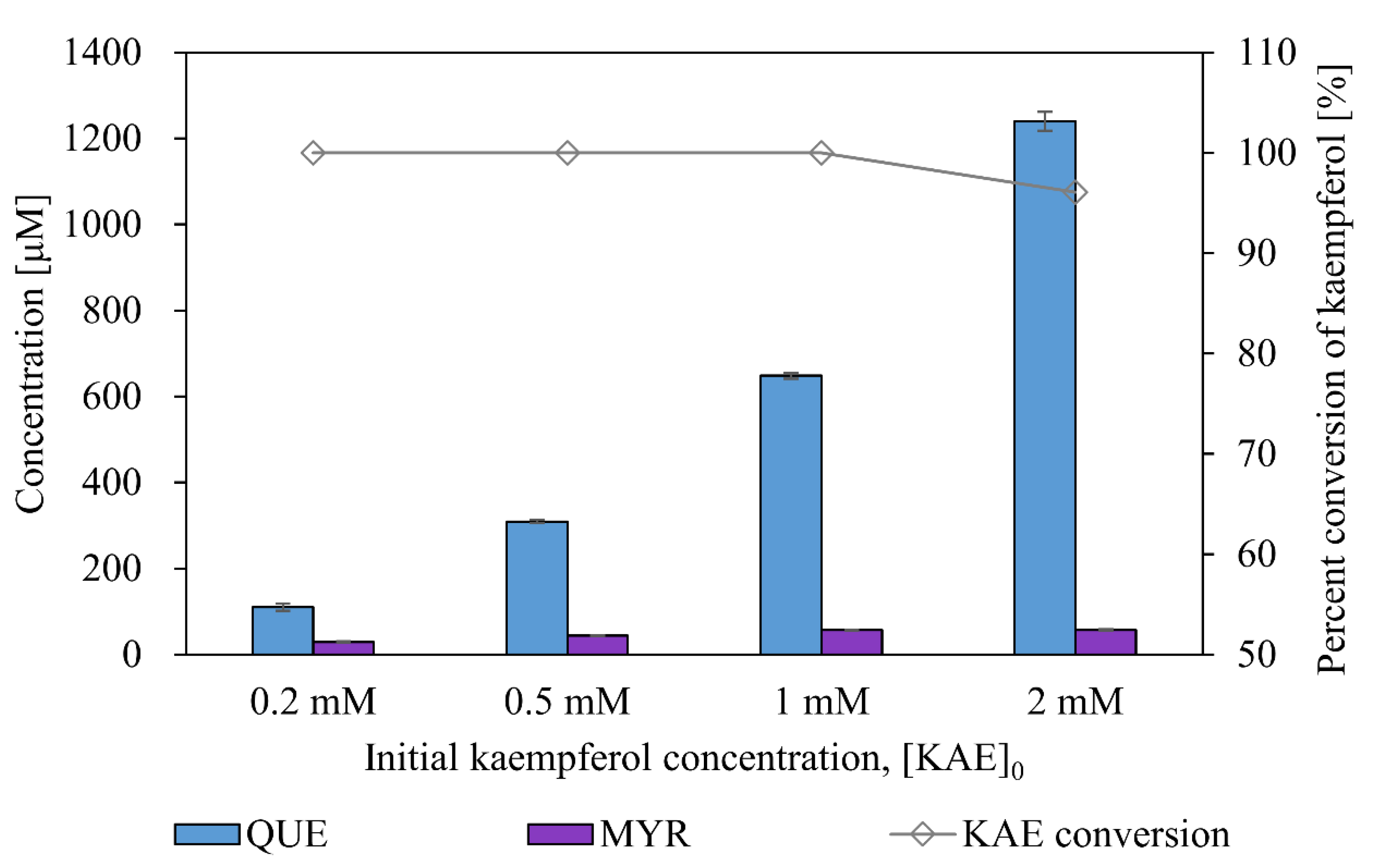
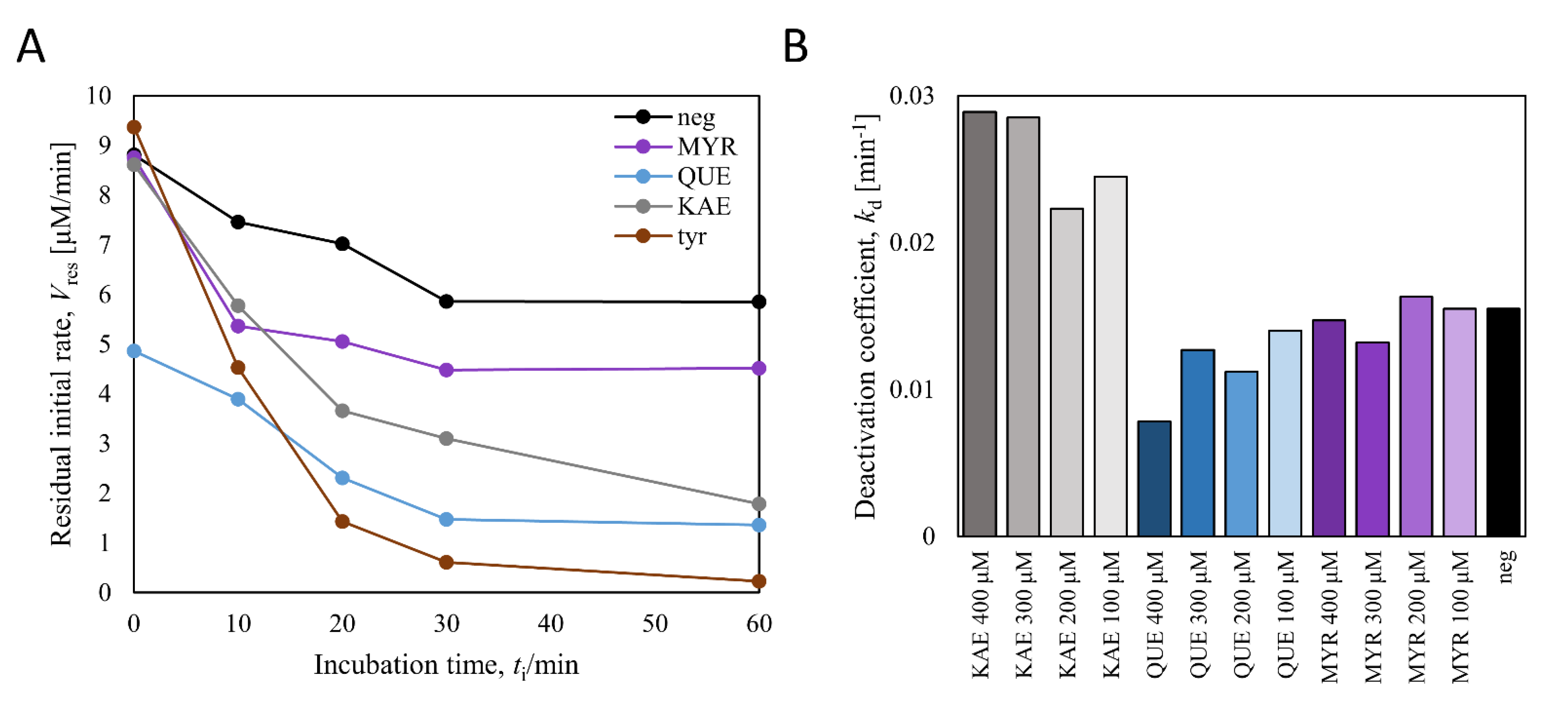
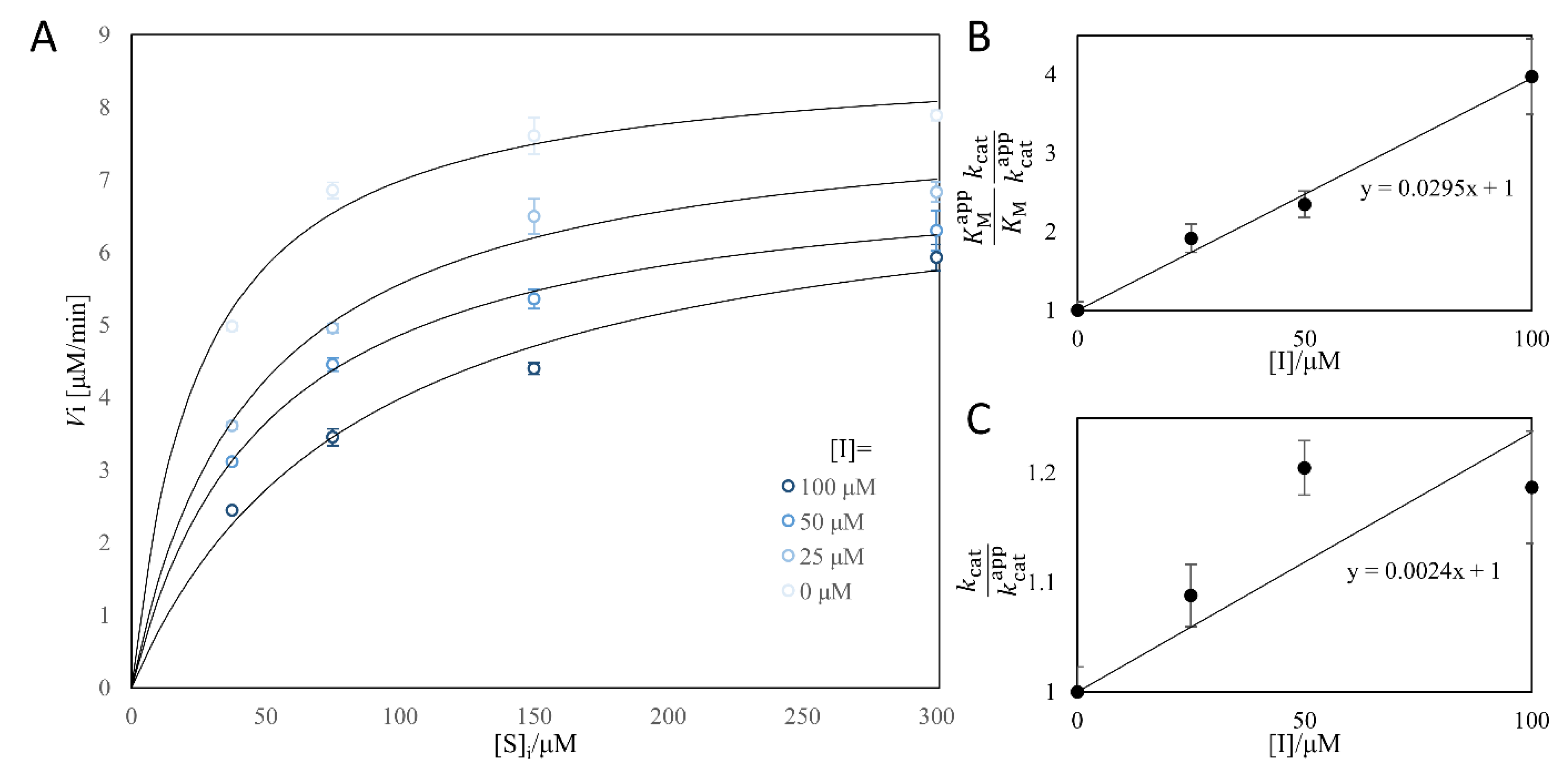
| pH | Enzyme Unit [U/μmol Enzyme] 1 | |
|---|---|---|
| Monophenolase Activity | Diphenolase Activity | |
| 5 | 117 ± 6 | 202 ± 5 |
| 6 | 231 ± 19 | 494 ± 5 |
| 7 | 376 ± 19 | 699 ± 42 |
| 8 | 276 ± 23 | 879 ± 28 |
Publisher’s Note: MDPI stays neutral with regard to jurisdictional claims in published maps and institutional affiliations. |
© 2021 by the authors. Licensee MDPI, Basel, Switzerland. This article is an open access article distributed under the terms and conditions of the Creative Commons Attribution (CC BY) license (https://creativecommons.org/licenses/by/4.0/).
Share and Cite
Song, H.; Lee, P.-G.; Kim, H.; Lee, U.-J.; Lee, S.-H.; Kim, J.; Kim, B.-G. Polyphenol-Hydroxylating Tyrosinase Activity under Acidic pH Enables Efficient Synthesis of Plant Catechols and Gallols. Microorganisms 2021, 9, 1866. https://doi.org/10.3390/microorganisms9091866
Song H, Lee P-G, Kim H, Lee U-J, Lee S-H, Kim J, Kim B-G. Polyphenol-Hydroxylating Tyrosinase Activity under Acidic pH Enables Efficient Synthesis of Plant Catechols and Gallols. Microorganisms. 2021; 9(9):1866. https://doi.org/10.3390/microorganisms9091866
Chicago/Turabian StyleSong, Hanbit, Pyung-Gang Lee, Hyun Kim, Uk-Jae Lee, Sang-Hyuk Lee, Joonwon Kim, and Byung-Gee Kim. 2021. "Polyphenol-Hydroxylating Tyrosinase Activity under Acidic pH Enables Efficient Synthesis of Plant Catechols and Gallols" Microorganisms 9, no. 9: 1866. https://doi.org/10.3390/microorganisms9091866
APA StyleSong, H., Lee, P.-G., Kim, H., Lee, U.-J., Lee, S.-H., Kim, J., & Kim, B.-G. (2021). Polyphenol-Hydroxylating Tyrosinase Activity under Acidic pH Enables Efficient Synthesis of Plant Catechols and Gallols. Microorganisms, 9(9), 1866. https://doi.org/10.3390/microorganisms9091866







